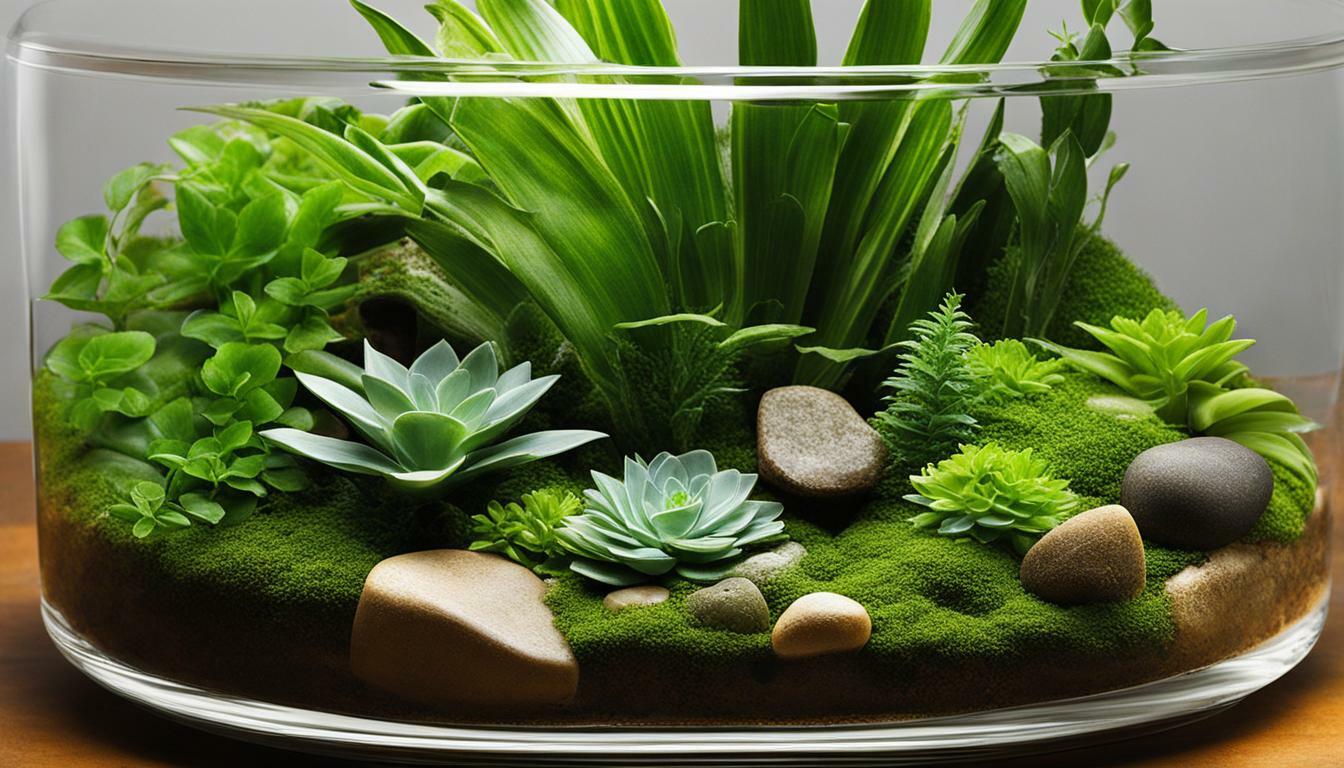Open terrariums are a beautiful addition to any indoor space, but they require careful attention and maintenance to thrive. Whether you’re a beginner or an advanced plant lover, nurturing open terrariums can be a rewarding experience that brings nature indoors. In this article, we will explore the essential tips and techniques for successfully maintaining open terrariums, ensuring the health and vitality of your miniature ecosystem.
Key Takeaways
- Humidity and watering are crucial factors in maintaining open terrariums.
- Proper lighting is essential for the growth and well-being of terrarium plants.
- Preventing mold and promoting airflow are key to ensuring a healthy environment.
- Regular cleaning and removal of rotting plants are important for plant health and aesthetics.
- Understanding the specific needs of different plants and making necessary adjustments is vital for success.
Understanding Humidity and Watering
Proper humidity and watering are essential for the health of your open terrariums. Maintaining the right balance can be a challenge, but with a few tips and tricks, you can ensure your plants thrive.
One common mistake is under-watering. Terrariums are closed spaces, and the humidity can quickly drop, especially in drier environments. To prevent under-watering, check the humidity levels regularly. If the soil feels dry to the touch, it’s a sign that your terrarium needs a little hydration. Use a spray bottle to mist the plants and surrounding area gently. This will help replenish the moisture and create a suitable environment for your plants to grow.
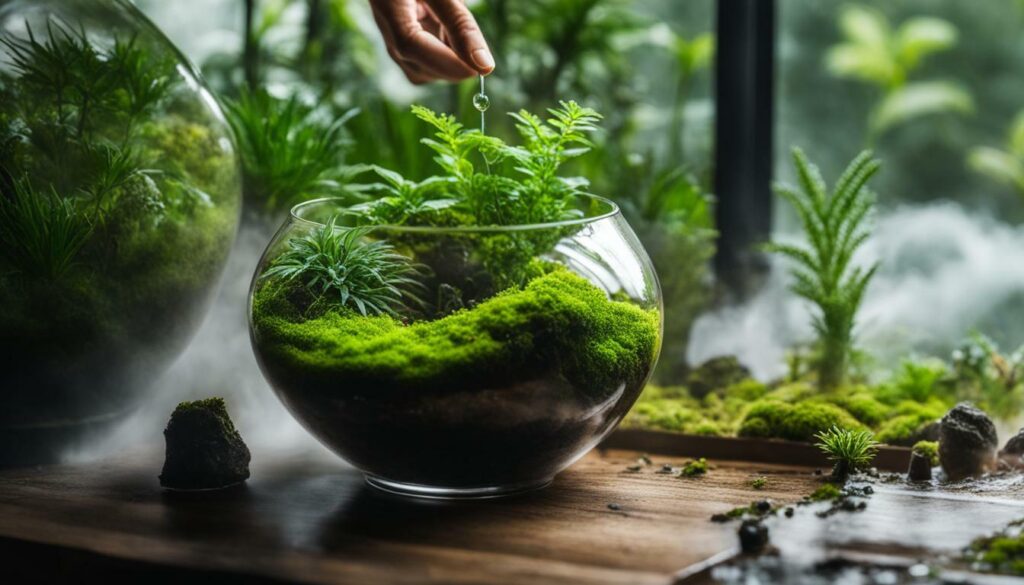
On the other hand, overwatering is a greater risk for open terrariums. It can lead to root rot, which is detrimental to the plants’ health. Instead of drenching the terrarium with water, opt for small, even sprays. This way, you can provide moisture without overwhelming the soil and roots. Pay attention to the condition of your plants and adjust your watering routine accordingly.
Remember, finding the right balance between humidity and watering is crucial for the success of your open terrariums. By understanding the needs of your plants and observing their behavior, you can ensure they thrive in their miniature ecosystem.
| Common Mistakes to Avoid | Best Practices |
|---|---|
|
|
Providing Adequate Lighting
Open terrariums need the right amount and type of light to thrive indoors. However, it is important to strike a balance, as too much or too little light can be detrimental to the plants. Direct sunlight, for example, can lead to scorched leaves and heat stress. To avoid this, it is best to place your terrarium in an area with indirect light or to use artificial light sources.
Indoor plants typically require around 12-16 hours of light per day. To achieve this, you can use fluorescent or LED grow lights. These lights emit the necessary wavelengths for photosynthesis and can be adjusted to suit the specific needs of your terrarium plants. Be sure to position the light source at an appropriate distance from the terrarium to avoid burning the plants.
Additionally, consider the type of plants you have in your terrarium. Some plants, such as succulents and cacti, prefer bright, direct light, while others, like ferns and mosses, thrive in low to medium light conditions. It’s important to research the light requirements of your specific plant species to ensure they receive the optimal lighting.
| Light Requirements | Plant Examples |
|---|---|
| Bright, direct light | Succulents, cacti |
| Indirect or medium light | Ferns, mosses |
Remember to periodically assess the lighting conditions and adjust as needed. Observe your plants for signs of light deficiency or excess, such as pale or leggy growth. With the right amount and type of light, your open terrarium will flourish, bringing a touch of nature indoors.
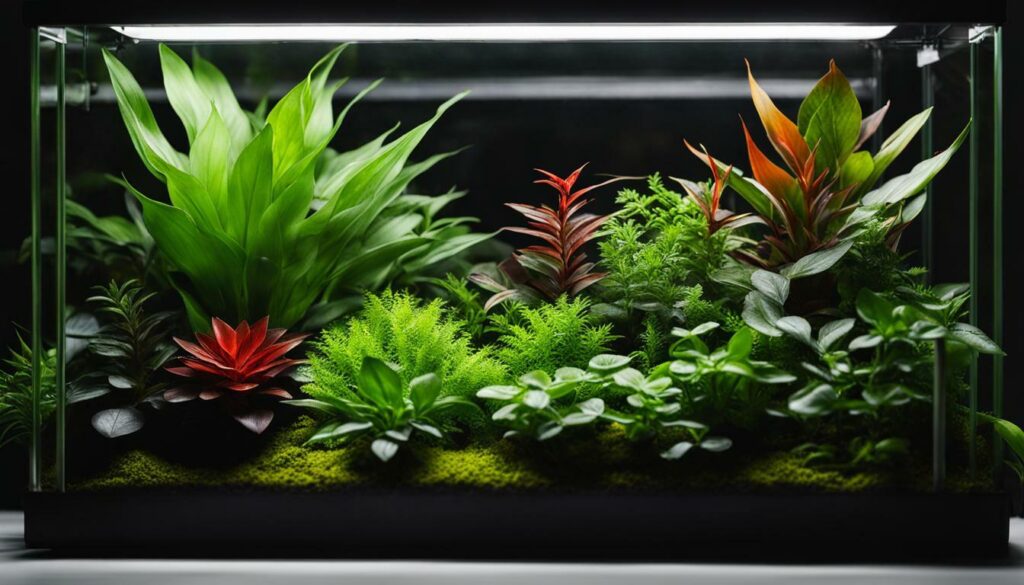
Mold can be a persistent problem in open terrariums, but with the right strategies, you can keep it at bay. Adequate airflow is crucial for preventing mold growth, as stagnant air creates a breeding ground for spores. One effective way to promote airflow is by placing a small fan near the terrarium to ensure constant circulation. Another option is to remove the lid or cover of the terrarium for short periods to allow fresh air to enter.
Additionally, you can use interventions such as hydrogen peroxide or chamomile tea to prevent mold. Diluted hydrogen peroxide can be sprayed on the affected areas to kill mold spores and inhibit their growth. Chamomile tea, known for its antifungal properties, can be brewed and used as a non-toxic mold prevention solution. Simply spray the tea onto the terrarium’s soil and surfaces to keep mold at bay.
Remember to regularly inspect your terrarium for any signs of mold. If you do spot mold growth, act quickly to remove any affected plants or materials. Cleaning the terrarium regularly is also important for preventing mold. Wipe down the glass walls and remove any debris or dead leaves that may have accumulated. Keeping the terrarium clean and ensuring proper airflow will help maintain a healthy environment for your plants.
Table: Comparison of Mold Prevention Interventions
| Interventions | Effectiveness | Additional Benefits |
|---|---|---|
| Hydrogen Peroxide | Highly effective against mold spores | Non-toxic and safe for plants |
| Chamomile Tea | Natural antifungal properties | Safe and chemical-free option |
By incorporating these mold prevention strategies into your terrarium maintenance routine, you can enjoy a thriving and mold-free indoor garden. Remember to monitor the humidity levels, provide adequate airflow, and promptly address any mold growth. With proper care, your open terrarium will be a beautiful and healthy ecosystem for your plants to thrive.
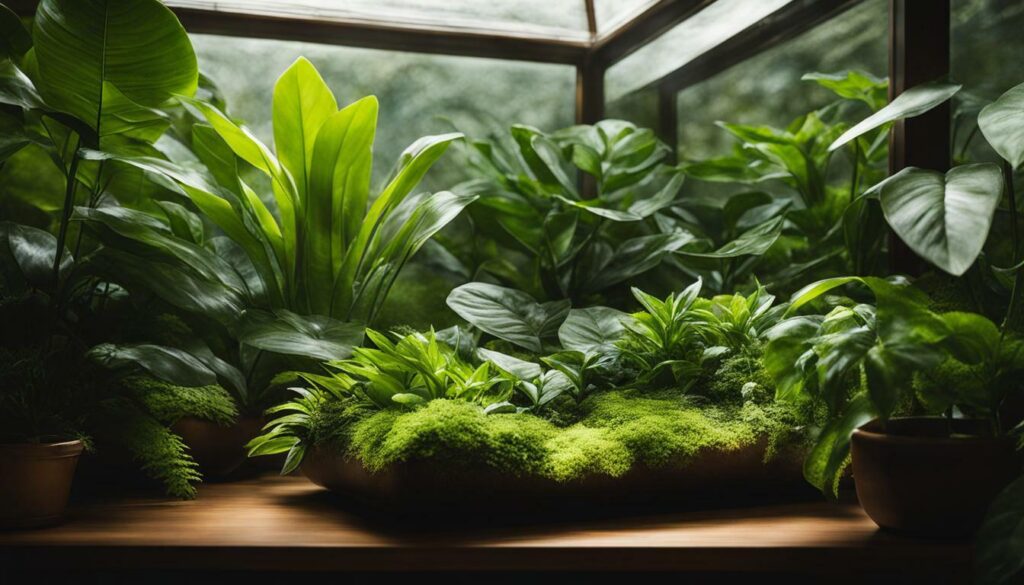
To keep your open terrarium looking its best, regular maintenance includes removing rotting plants and trimming overgrowth. Neglecting these tasks can hinder the overall aesthetic and lead to overcrowding, affecting your plants’ health and longevity. By taking a proactive approach, you can ensure a thriving and visually pleasing terrarium.
“A well-maintained terrarium not only showcases the natural beauty of your plants but also creates a harmonious environment,” says horticulture expert, Dr. Green.
“When a plant starts to rot, it not only becomes an eyesore but can also spread disease to nearby plants. Regularly inspect your terrarium and remove any decaying foliage or plants to prevent further complications.”
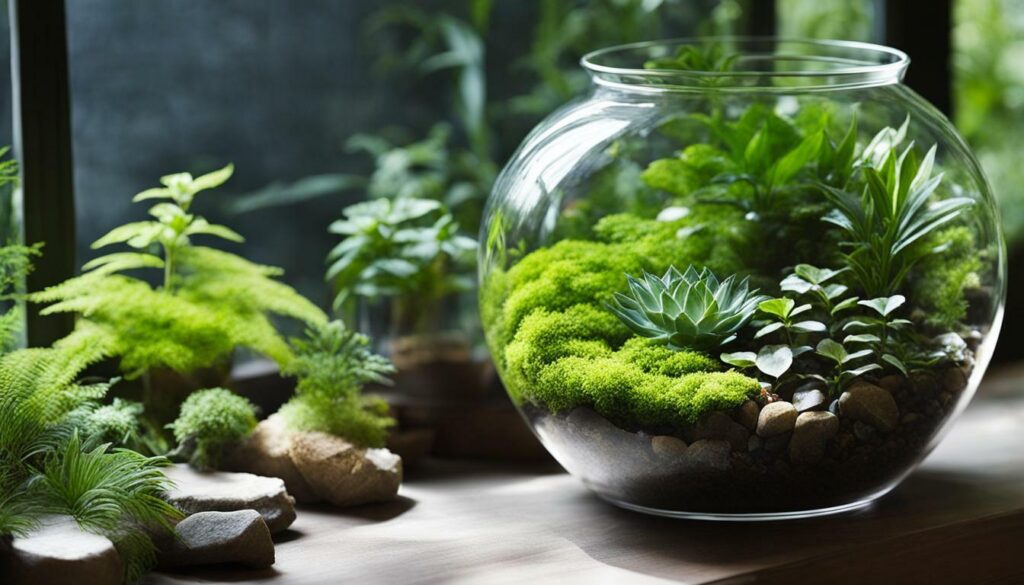
Trimming overgrown plants is equally important to maintain the desired aesthetic and prevent overcrowding. Dr. Green advises, “Overgrown plants can deprive other plants of light and nutrients, leading to stunted growth. Regularly prune any excessive growth to promote airflow and ensure all plants receive their fair share of resources.”
Essential Tips for Removing Rotting Plants and Trimming Overgrowth
- Use sterilized pruning shears to remove rotting foliage. Clean the blades with rubbing alcohol before and after each use to prevent the spread of diseases.
- Identify the cause of rotting, such as overwatering or fungal infestation. Adjust your watering schedule accordingly and address any underlying issues.
- When trimming overgrown plants, focus on removing excessive branches or stems to maintain a balanced appearance in your terrarium.
- Dispose of the removed plants in a responsible manner, far from your terrarium, to prevent potential contamination.
By practicing regular maintenance and promptly addressing any issues, you can ensure your open terrarium remains vibrant and free from the negative effects of rotting plants and overgrowth.
| Benefits | Challenges |
|---|---|
| Enhanced aesthetic appeal | Spread of diseases |
| Improved plant health | Stunted growth |
| Optimal resource allocation | Limited airflow |
Regular Cleaning for Plant Health and Visibility
Regular cleaning is crucial for maintaining the health and beauty of your open terrarium. Keeping the glass clean not only enhances the visibility of your plants but also ensures their overall well-being. Dust and dirt can accumulate on the glass surface, blocking the sunlight and inhibiting proper photosynthesis. Additionally, these particles can create a breeding ground for harmful pests and diseases.
To clean your open terrarium, start by carefully removing any larger debris or fallen leaves. Gently wipe the interior glass surfaces using a soft, lint-free cloth or a sponge. Avoid using chemical cleaners or harsh detergents as they can leave behind residues that may harm your plants. Instead, opt for a mixture of mild liquid soap and warm water, ensuring that all soap is thoroughly rinsed off to prevent any negative effects.
For stubborn stains or mineral deposits on the glass, a solution of equal parts water and vinegar can be used. Dip a cloth or sponge into the solution and gently scrub the affected areas. Rinse thoroughly with clean water afterward. Remember to clean the outside of the terrarium as well, as this will contribute to the overall aesthetic appeal of your indoor garden.
By incorporating regular cleaning into your terrarium maintenance routine, you can create a healthy and visually stunning environment for your plants. It’s important to note that cleaning frequency may vary depending on the specific needs of your terrarium and the surrounding environment. Observe your plants closely and clean the glass whenever you notice a buildup of dust or dirt. With proper care, your open terrarium will thrive and bring the beauty of nature into your home.
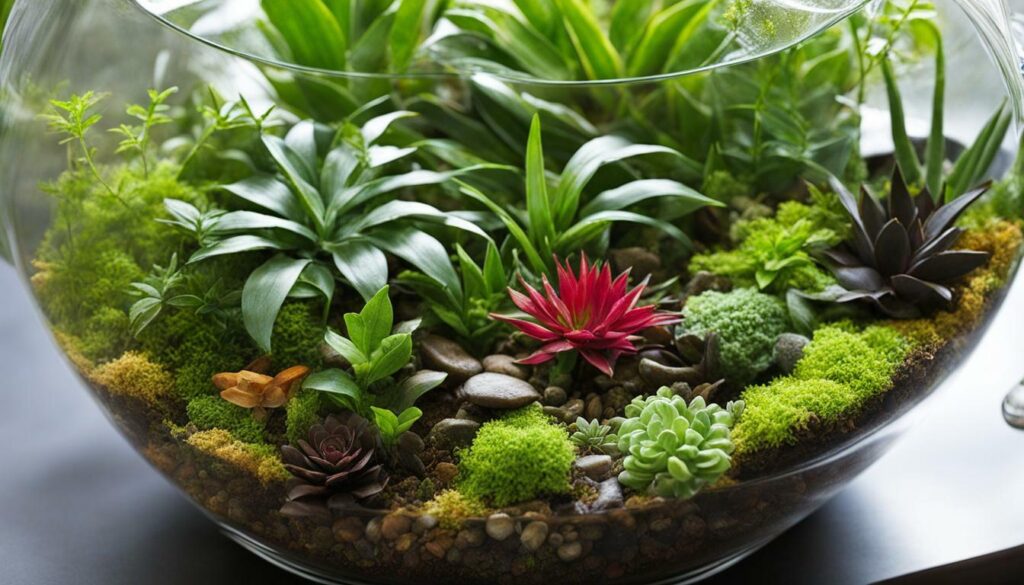
Note: Regular cleaning is essential for maintaining the health and visibility of your open terrarium. It helps to remove dust, debris, and stains that can hinder plant growth and disrupt the overall aesthetic appeal. By following these cleaning practices, you can ensure that your open terrarium remains a vibrant and captivating centerpiece in your home.
Understanding Plant Needs and Making Adjustments
Each plant in your open terrarium has its own requirements, and it’s important to tailor your care to meet their needs. By understanding the specific needs and behaviors of different plants, you can ensure their optimal growth and health. Here are some key considerations when it comes to adjusting your plant care:- Lighting: As mentioned earlier, providing adequate lighting is crucial for open terrariums. However, it’s essential to find the right balance. Some plants thrive in bright, indirect light, while others prefer low light conditions. Take the time to research the lighting preferences of your plants and place them accordingly.
- Watering: Watering is another critical aspect of plant care. Monitor the humidity levels in your terrarium regularly and water your plants accordingly. Under-watering can deprive your plants of essential moisture, while overwatering can lead to root rot. It’s best to water your terrarium in small, even sprays to prevent any excess accumulation.
- Airflow: Good airflow is essential for preventing mold growth and promoting plant health. Ensure that your terrarium has proper ventilation by slightly opening the lid or placing it in a well-ventilated area. You can also incorporate interventions like hydrogen peroxide or chamomile tea to prevent mold formation.
| Plant | Lighting Preference | Watering Requirement | Airflow Needs |
|---|---|---|---|
| Succulents | Bright, indirect light | Infrequent watering | Good airflow, avoid excess moisture |
| Ferns | Low to medium indirect light | Consistent moisture, but not waterlogged | High humidity and good airflow |
| Cacti | Bright, direct light | Infrequent watering, allow soil to dry between waterings | Good airflow, avoid excess moisture |
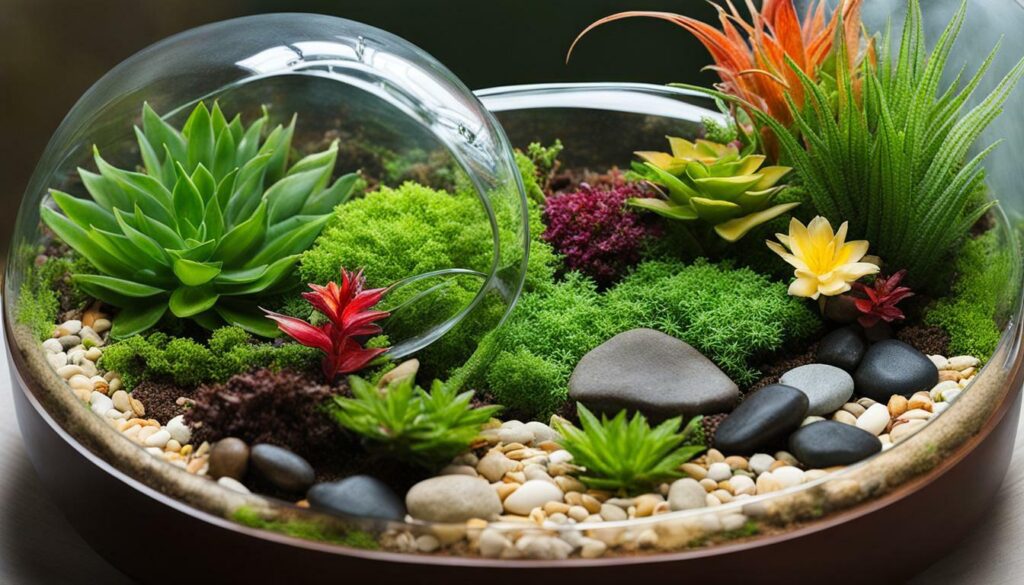 Note: The table above summarizes the lighting preferences, watering requirements, and airflow needs of some common terrarium plants. Rotate the image above for the complete view.
Note: The table above summarizes the lighting preferences, watering requirements, and airflow needs of some common terrarium plants. Rotate the image above for the complete view.
Open terrariums offer endless possibilities for creating airy designs that bring a touch of nature indoors.
When it comes to open terrariums, the design options are limitless. These miniature indoor gardens provide the perfect opportunity to bring nature indoors while showcasing your creativity. Whether you’re a beginner or an advanced plant lover, open terrariums allow you to explore a world of airy designs that are both breathable and natural.
“Open terrariums offer a unique way to showcase your favorite plants while creating a stunning centerpiece for any room.”
To achieve an airy design in your open terrarium, it’s important to consider a few key factors. First, make sure the terrarium has proper airflow to prevent any mold growth. This can be achieved by placing the terrarium in a well-ventilated area or by using interventions like hydrogen peroxide or chamomile tea to keep mold at bay.
Additionally, choose plants that thrive in an open terrarium environment and trim any overgrowth to maintain the desired aesthetic and prevent overcrowding. Regular cleaning of the glass helps not only with plant health but also enhances the visibility of your beautiful arrangement.
Remember to pay attention to the specific needs of your plants and make any necessary adjustments. Understanding the lighting, watering, and humidity requirements of each plant ensures their optimal growth and long-term health within your open terrarium.
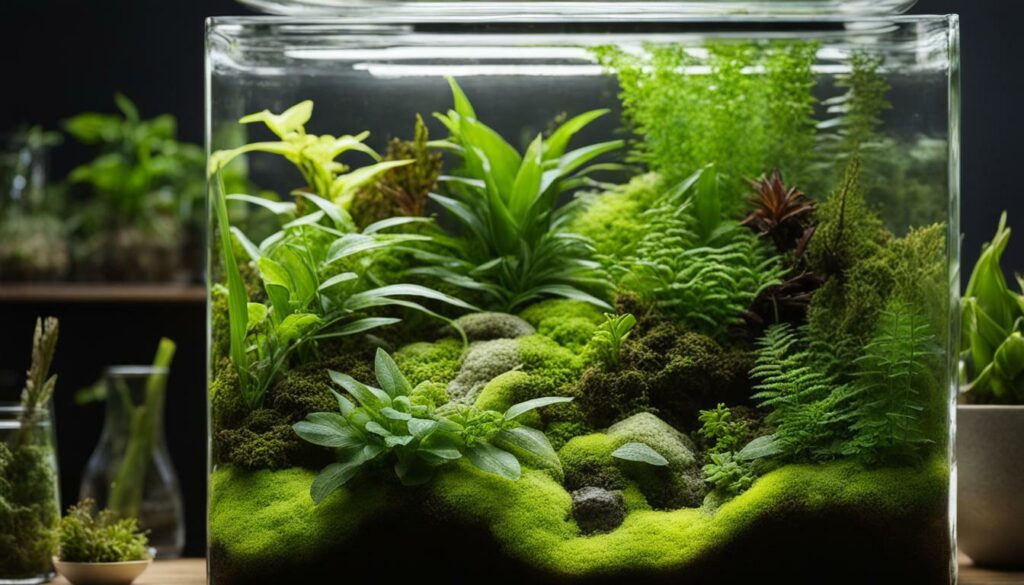
With these tips in mind, you’ll be on your way to mastering the art of maintaining open terrariums. Create your own little slice of nature indoors and enjoy the beauty of your airy designs.
[Derived from Meta description]
Whether you’re a beginner or an experienced plant enthusiast, these practical tips will help you nurture your open terrariums with confidence. Mastering the art of maintaining open terrariums requires careful attention to various factors, such as humidity, watering, lighting, mold prevention, plant care, and cleaning. By understanding and implementing these tips, you can create a thriving indoor nature oasis.
Humidity and Watering
One of the most common mistakes in open terrarium maintenance is under-watering. To ensure your terrarium thrives, regularly check the humidity levels and add water if necessary. However, overwatering poses a greater risk and can lead to root rot. It’s important to water your terrarium in small, even sprays, allowing the soil to absorb the moisture without becoming waterlogged. Striking the right balance between humidity and watering is key to keeping your plants healthy.
Providing Adequate Lighting
Open terrariums require proper lighting for optimal growth. While natural sunlight is essential, direct sunlight can be harmful and cause plant burn. It is best to place your terrarium in an area that receives indirect light or use artificial light sources. This ensures that your plants receive the necessary light without the risk of damage.
Preventing Mold and Promoting Airflow
Mold is a common issue in open terrariums, but it can be prevented by ensuring good airflow. Proper ventilation helps to minimize excess moisture, which is essential in preventing mold growth. If you notice any signs of mold, interventions such as hydrogen peroxide or chamomile tea can be used to combat it effectively.
Removing Rotting Plants and Trimming Overgrowth
To maintain the desired aesthetic and prevent overcrowding in your open terrarium, it is crucial to remove any rotting plants promptly. These plants can contribute to mold growth and hinder the health of the surrounding plants. Additionally, regularly trimming overgrown plants will help to maintain a balanced and visually appealing terrarium environment.
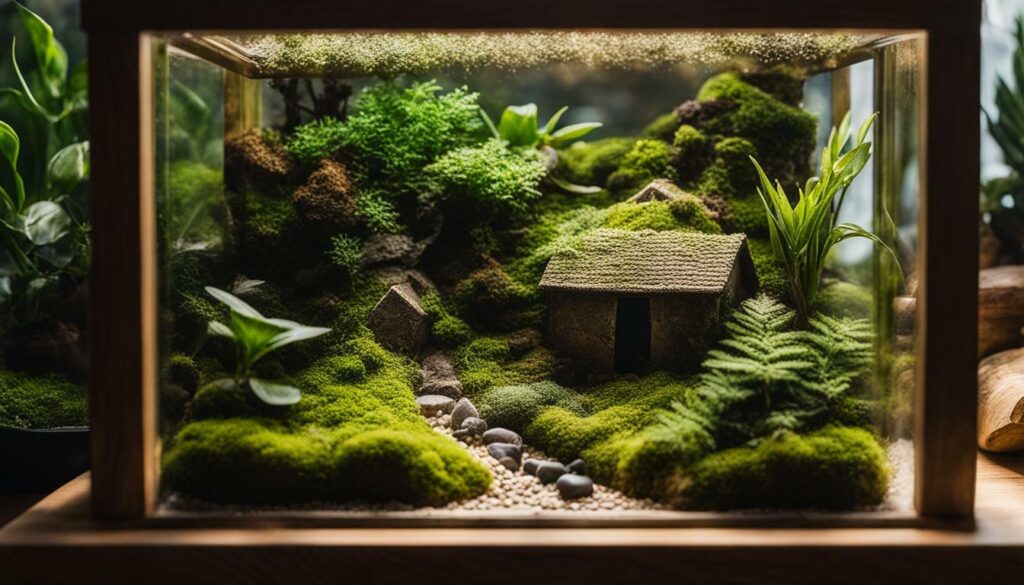
Regular Cleaning for Plant Health and Visibility
Regular cleaning of the terrarium glass is imperative for both plant health and visibility. Dust and debris can obstruct the light and prevent the plants from thriving. By keeping the glass clean and clear, you enhance the overall appearance of your terrarium and ensure that your plants have optimal growing conditions.
Understanding Plant Needs and Making Adjustments
Each plant has specific needs and behaviors that should be understood and catered to in your open terrarium. Observing your plants closely will enable you to identify any signs of stress or growth issues. By making necessary adjustments, such as adjusting watering frequency or providing additional support, you can ensure that each plant thrives in its unique environment.
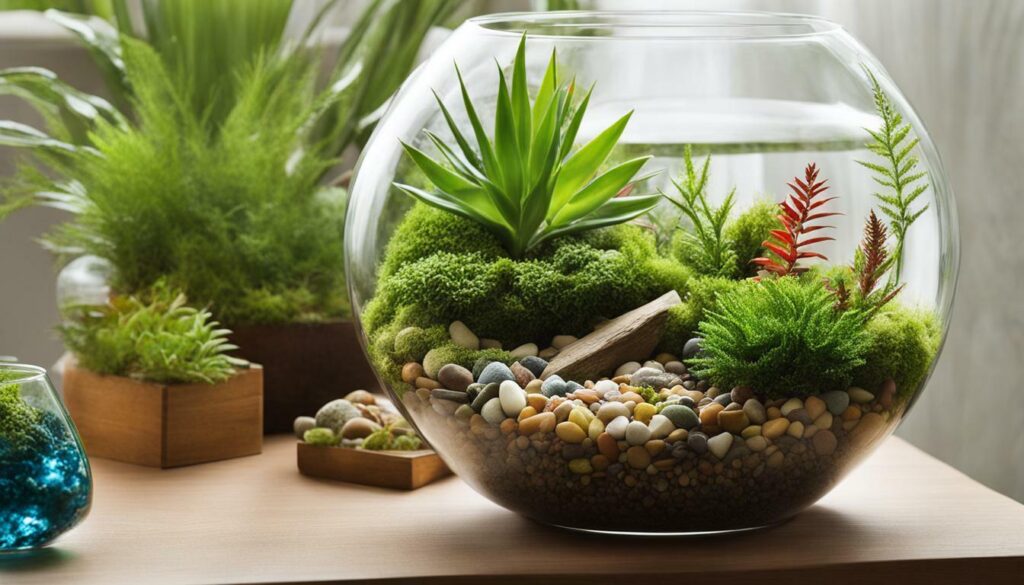
By following these practical tips and implementing them into your open terrarium maintenance routine, you can create a beautiful and thriving indoor nature oasis. Whether you’re a beginner or an advanced plant lover, these tips will give you the confidence to nurture your open terrariums and bring the wonders of nature indoors.
[Derived from factual data]
Mastering the art of maintaining open terrariums involves careful attention to humidity, watering, lighting, mold prevention, plant care, and cleaning. One common mistake that beginners make is under-watering their terrariums. To ensure the plants thrive, it’s important to regularly check the humidity levels and add water as needed. However, overwatering is a greater risk and can lead to root rot, so it’s advisable to water the terrarium in small, even sprays to maintain the right moisture balance.
Proper lighting is essential for the health of the plants in open terrariums. While they need light to grow, direct sunlight can scorch the delicate foliage. It’s best to place the terrarium in an area with indirect or artificial light that mimics the natural conditions. This will provide the necessary light without causing harm to the plants.
Mold is a common issue in open terrariums, but it can be prevented with proper care. Good airflow is crucial for preventing mold growth, so ensure there is enough ventilation. Additionally, you can use interventions like hydrogen peroxide or chamomile tea to keep mold at bay. Regularly inspect the terrarium to identify any rotting plants and promptly remove them to prevent further mold development.
Trimming overgrowth is important for maintaining the desired aesthetic and preventing overcrowding in the terrarium. By removing excess foliage, you create space for the plants to thrive and maintain a balanced environment. Additionally, regular cleaning of the terrarium glass is essential for plant health and visibility. Dust and dirt can block sunlight and hinder plant growth, so make it a habit to clean the glass regularly to ensure optimal conditions.
| Section | Aspect |
|---|---|
| Humidity and Watering | Check and adjust the humidity levels, and water in small sprays to prevent under or over-watering |
| Providing Adequate Lighting | Place the terrarium in an area with indirect or artificial light to ensure optimal growth |
| Preventing Mold and Promoting Airflow | Ensure good airflow, use interventions like hydrogen peroxide or chamomile tea to prevent mold |
| Removing Rotting Plants and Trimming Overgrowth | Promptly remove rotting plants, keep overgrowth in check to maintain aesthetic and prevent overcrowding |
| Regular Cleaning for Plant Health and Visibility | Clean the terrarium glass regularly to prevent dust and dirt buildup |
| Understanding Plant Needs and Making Adjustments | Understand the specific needs of plants and make necessary adjustments to ensure their well-being |
Summarizing the Key Aspects
To master the art of maintaining open terrariums, it’s crucial to pay attention to key aspects such as humidity, watering, lighting, mold prevention, plant care, and cleaning. Proper watering techniques, including checking and adjusting humidity levels, prevent under or over-watering. Adequate lighting, provided through indirect or artificial sources, ensures optimal growth. Preventing mold growth requires airflow and interventions like hydrogen peroxide or chamomile tea. By promptly removing rotting plants and trimming overgrowth, you maintain the desired aesthetic and prevent overcrowding. Regular cleaning of the terrarium glass keeps it in optimal condition for plant health and visibility. Understanding the specific needs of plants and making necessary adjustments will lead to successful maintenance of open terrariums.
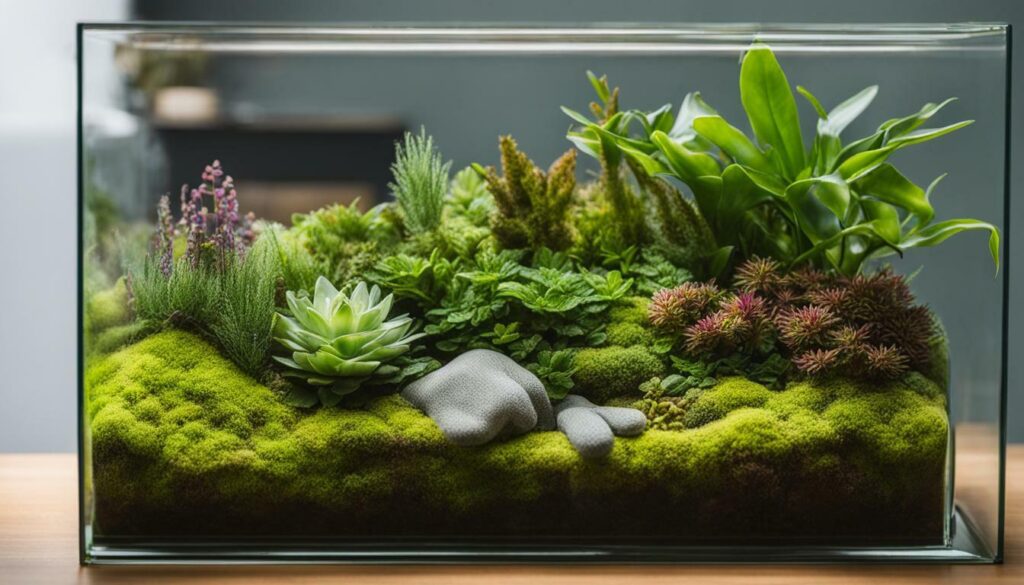
With the right knowledge and practices, you can ensure the successful maintenance of your open terrariums, allowing nature to flourish indoors.
Mastering the art of maintaining open terrariums requires careful attention to several key factors. One common mistake is under-watering, which can lead to dry and unhealthy plants. To avoid this, regularly check the humidity levels in your terrarium and add water if necessary. However, overwatering is an even greater risk that can result in root rot. It’s best to water your terrarium in small, even sprays to maintain the optimal moisture balance.
Proper lighting is crucial for the health and growth of plants in your open terrarium. While they need light to thrive, direct sunlight can be harmful and cause burns. It’s best to place your terrarium in a location with indirect or artificial light, providing the right amount of illumination without the risk of overheating or sun damage.
Mold is a common issue in terrariums, but it can be prevented by ensuring good airflow and taking proactive measures. Keep the terrarium well-ventilated to promote air circulation, and consider using interventions such as hydrogen peroxide or chamomile tea to prevent mold growth. Promptly remove any rotting plants to prevent the spread of mold and maintain a healthy environment.
In addition, it’s important to regularly trim overgrown plants in your open terrarium to maintain the desired aesthetic and prevent overcrowding. This allows each plant to thrive and receive an adequate amount of space and resources. Furthermore, don’t forget to clean the terrarium glass regularly. This not only improves plant health by allowing more light to penetrate but also ensures better visibility and enjoyment of your indoor nature display.
Successful maintenance of open terrariums involves understanding the specific needs and behaviors of different plants and making necessary adjustments. Each plant has unique requirements, and by observing their growth patterns and responding accordingly, you can create a harmonious and thriving ecosystem in your terrarium.
By following these tips and techniques, you can establish a beautiful and healthy open terrarium that brings the beauty of nature indoors. With proper care and attention, your terrarium will become a flourishing mini-ecosystem, providing a calming and enchanting display for your home or office.
Can I Learn Terrarium Maintenance Techniques at Your Workshops?
Yes, you can learn all about terrarium maintenance techniques at our workshops. Our terrarium workshops for creativity are designed to teach you everything you need to know about caring for and maintaining your terrariums. Join us and discover the secrets to keeping your terrariums thriving.
FAQ
How often should I water my open terrarium?
It’s important to check the humidity levels and add water if necessary, but be cautious of overwatering. Watering should be done in small, even sprays to avoid root rot.
Can I place my open terrarium in direct sunlight?
Direct sunlight can burn the plants in your terrarium. It’s best to provide indirect or artificial light for optimal growth.
How can I prevent mold in my open terrarium?
Good airflow is crucial for preventing mold. You can also use interventions like hydrogen peroxide or chamomile tea. Promptly removing rotting plants helps prevent mold growth as well.
Should I trim overgrown plants in my open terrarium?
Yes, trimming overgrowth is important for maintaining the desired aesthetic and preventing overcrowding in your open terrarium.
How often should I clean my open terrarium glass?
Regular cleaning of the terrarium glass is important for both plant health and visibility. It’s recommended to clean it on a regular basis.
How should I adjust my open terrarium for different plant needs?
Understanding the specific needs and behaviors of different plants in your open terrarium is crucial. Make necessary adjustments like lighting, watering, and positioning to ensure their well-being.
What are some tips for creating an airy and natural open terrarium design?
To achieve an airy and natural feel, focus on using breathable materials and incorporating elements like rocks, sand, and driftwood in your open terrarium design.
Are the tips provided suitable for beginners or advanced plant lovers?
The tips provided in this article are perfect for both beginners and advanced plant lovers who want to enjoy the beauty of open terrariums and bring nature indoors.
What are the key aspects to master for maintaining open terrariums?
Mastering the art of maintaining open terrariums requires careful attention to humidity, watering, lighting, mold prevention, plant care, and cleaning.

